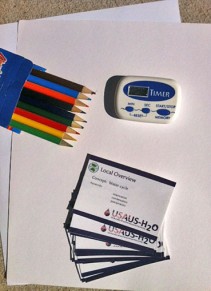Resources
These resources are made available for and by teachers for helping students learn about the water cycle.
Water in the Anthropocene is a three minute film charting the global impact of humans on the water cycle. Evidence is growing that our global footprint is now so significant we have driven Earth into a new geological epoch—the Anthropocene.
Human activities such as damming and agriculture are changing the global water cycle in significant ways.
As datasets build upon one another, the film charts Earth’s changing global water cycle, why it is changing and what this means for the future. The vertical spikes that appear in the film represent the 48,000 large dams that have been built.
Created by: AdrianJ USAUS-H2O
 How to play USAUS-H2O Conceptionary
How to play USAUS-H2O Conceptionary
Materials needed:
- Blank paper
- Colored pencils
- Conceptionary cards (click example card below for a PDF of all cards)
- Timer
Rules:
Participants organize into groups of 3-5 people and one team member is designated as the ‘science illustrator’. Only the ‘science illustrator’ is given a card with a water concept and 3 key words identified. The team then attempts to guess the key words and water concept as the ‘science illustrator’ draws. The drawing portion is typically 2 minutes, but the time can be lengthened if teams are struggling to guess the water concept and key words.
Review:
The most fun is when each of the drawings that the ‘science illustrator’ produces is projected and reviewed by the entire group. A variety of technologies can be employed to project the drawings including ipad photo and connection to a data projector, directly to a document camera or photograph and upload to a computer.
What participants learn:
- Players realize that complex concepts can be effectively communicated with rudimentary tools with a few minutes.
- Players appreciate that artistic talent is not needed to be an effective communicator. Some of the most effective drawings are not artistic, but use creative linkages and good caricatures.
- Effective use of colors can highlight important features, by providing realism or by drawing attention to key processes.
- A diversity of approached can be employed to communicate a specific concept.
- There are some iconic symbols which are useful in developing conceptual diagrams.
Created by: AdrianJ USAUS-H2O
The USAUS-H2O diagram creator connects directly to the IAN symbol library database so that users can search for symbols by keywords, browse the albums, select from an IAN project symbol set (check out the USAUS-H2O set), or work from their lightbox collection. This allows students to quickly and easily develop diagrams detailing various issues with the water cycle in their area.
For more information, check out this blog post.
There is also a PDF of all symbols (regularly updated)
Created by: AdrianJ USAUS-H2O
Very good TED-ED video, and lesson plans built around it on this link.
http://ed.ted.com/lessons/what-really-happens-to-the-plastic-you-throw-away-emma-bryce
Created by: JudyO USAUS-H2O
Check out this fun creation by green builder Adam Katzman as an example of how wastewater can be treated naturally.
Created by: AdrianJ USAUS-H2O
This game is from South-East Water in Victoria, Australia. Click the image to play!
Created by: AdrianJ USAUS-H2O
This is an excellent educational game developed by SEQWater (the South-East Queensland Water supply authority). Click the image to play!
Created by: AdrianJ USAUS-H2O
Posted by JanetR University of Canberra High School Kaleen on May 20 6:46 pm
found this and thought it was really good and worth sharing http://water.usgs.gov/edu/watercycle-kids-adv.html
Post Comment
To leave a comment, you must be signed in











